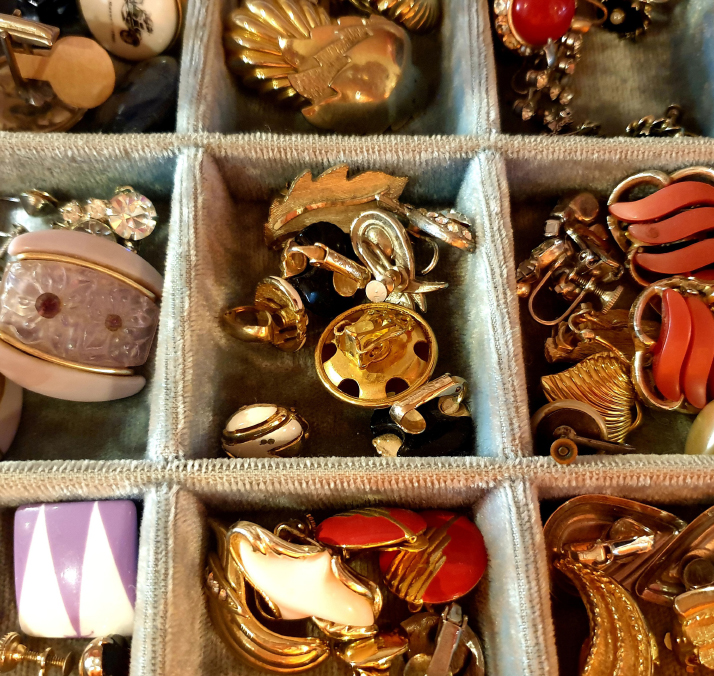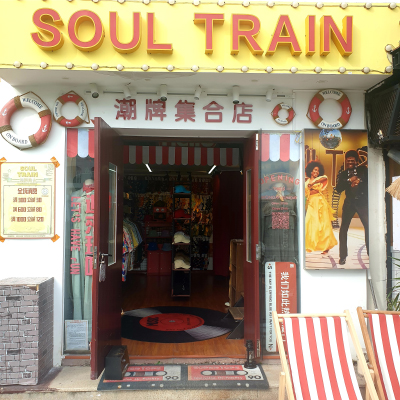| Lifestyle |
| Young Chinese throw out the new and bring in the old | |
|
|
 A treasure trove of vintage trinkets at Mega Store, a vintage shop in downtown Beijing's Gulou area, in November 2023 (ELSBETH VAN PARIDON)
Settled in the-see-and-be-seen Shapowei area of Xiamen City, in China's southeastern province of Fujian, the Soul Train vintage clothing store oozes an unmistakable air of retro urban cool. Stepping inside last July, this writer found herself basking in the retro glow of the platform shoes, chunky sandals, timeless dresses and tapestries of accessories curated there. Plus, unlike many vintage stores that specialize in women's fashion, the store also offers the boys a chance to score some fly menswear and make some hip vintage noise. Soul Train is one example of secondhand street style and sustainability all rolled into one too-cool-for-school fashion funk. But with yard sales still to gain popularity among most Chinese consumers, and a lingering preference for newly made goods, what is the vintage fashion scene like in 2020s China? After all, when it comes to clothing specifically, the right vintage touch can take you from frumpy grandma to foxy mama in a heartbeat. Superstition trumps trend? This article will equate the terms vintage and secondhand. For most Chinese consumers, both terms denote "old clothes" and in fact adhere to the Cambridge Dictionary's definition of vintage as "used, but in good condition." So let's take it from the top. Like their peers in other markets, Chinese millennials and Gen Zs are changing their shopping habits. Their been-there-done-that approach to purchasing everything from clothes to tech means they're always on the lookout for something fresh. Rapidly growing in popularity, secondhand and clothes-sharing sites in China such as Plum, Xianyu, Ycloset and Zhuanzhuan are already doing their part to spread the word that used items, in general, cost less, tszuj up your style and benefit the planet. According to market data portal Statista, in 2022, China's secondhand consumer goods market was valued at about 1.55 trillion yuan ($216 billion), up from about 1.3 trillion yuan ($181 billion) in 2021. In 2022 alone, about 3.84 billion used items were sold in the country. Take the example of Xianyu, an online platform for secondhand items owned by Chinese tech giant Alibaba Group. To date, Xianyu has more than 500 million users. According to data released by the platform in late May 2023, the number of products listed on the platform since its launch in 2014 had exceeded 1 billion. "With continuous change in consumer attitudes in China and deepening environmental awareness, the trade of used goods has evolved from a relatively niche money-saving option to a trendy lifestyle choice, especially favored by young consumers born in the 1980s and 90s," Beijing Review reporter Lu Yan wrote in an article on China's secondhand goods market late last year. Chinese acceptance of vintage clothing appears to go hand in hand with internationalization in mega and large cities. China may produce and consume more clothing than anywhere else in the world, but when it comes to buying used clothes, the country lags behind the other major players in the fashion industry. While secondhand fashion may not be a new phenomenon to people in the West—yard sales and thrift stores are common features of the urban landscape in, for example, the U.S. and Europe—China's resale market has been somewhat stunted by fears of counterfeiting, the persistent social status attached to new goods and even superstitions about wearing other people's clothes. For example, it is traditionally considered bad luck to wear someone else's clothes, especially if that person has already passed away. Furthermore, it's also considered beneath a person and shows a lack of wealth. But with the passage of time, some of these beliefs are no longer passed down and many contemporary Chinese youth see things differently. One Shanghai-based college student, for example, told this author she and her friends enjoy the occasional afternoon fine-combing their way through the racks of the city's vintage stores to hunt down hidden gems. "It's a great way to get some solid fashion pieces to spruce up your wardrobe. Plus, often, these items have already stood the test of time, so I'm confident they will last me a decade or more as well," she explained. Many of today's Chinese youth, and Gen Zs especially, no longer feel chained to old-fashioned beliefs about "face." A proclivity for true quality now arises within a generation that has the luxury of enjoying the finer things in life; a world away from their grandparents—or even their parents. And store owners, too, are noticing the shifting tides. A representative of Mega Store, a secondhand clothing haven in downtown Beijing's Gulou area that mostly sells items from European countries, the U.S. and Japan, told this author, who was there to flip through the clothing hangers and gather some vintage intel not too long ago, that "young Chinese today are more in touch with different cultures, often courtesy of social media, and they are happy to expand their horizons—both in terms of life and fashion. They like infusing their ensembles an 'exotic' tang, a taste of the 'old'." The rep did also point out one very noteworthy detail: Whereas in the West, vintage or secondhand consumption often relates to the pursuit of sustainability on the consumer side, Chinese customers are usually attracted by the styles—and their cheaper price tags. "However, I am absolutely sure that in the years to come, younger generations here will push the dialogue surrounding vintage consumption more toward one of sustainability and environmental awareness," she added. Social media figures reveal the growing popularity of vintage. The hashtag "vintage chuanda" (the latter meaning "outfits") on Douyin, the Chinese version of TikTok, featured a whopping 89 million posts and videos (and counting by the day, you can take my word for it) as of January 9, with vintage-loving vixens showing people how to best throw out the new and bring in the old. Speaking of short videos…  The Soul Train vintage store in the trendy Shapowei area of Xiamen, Fujian Province, in July 2023 (ELSBETH VAN PARIDON)
Buzz, buzz, buzz A camera moves through a haze of hairspray clouding up a small hair salon in Tianjin Municipality, a 30-minute high-speed train ride from Beijing… As the fog clears, the lens zooms in on an absolutely fabulous flamboyant phoenix that appears to be dancing with an equally exuberantly "dyed" "dragon." This is not the Chinese adaptation of the Tony Award-winning Broadway musical Hairspray. This is the return of the Tianjin beehive—though the same mantra, "more is more," apparently applies. "The higher the updo, the more beautiful you'll look!" hairstylist Zhu said in the short video that went viral on Douyin late last November. The Tianjin dayi pantou, which translates as "auntie beehive," refers to local women aged 50 and up, with tousled hair of all colors, sprinkled with a dusting of glitter. And just FYI: the hairdo is an official part of the city's intangible cultural heritage. Its most elaborate styles include Chinese dragon or phoenix patterns that are sprayed onto the beehive and appear to move as the hairstyle bops around. Ten years ago, these hairstyles could be still seen in the wild all over Tianjin, from the city's parks and markets to its buses. Today, the hive is returning as a heavy hitter on Chinese social media. From all over China, Gen Zs in particular are flocking to the city's unpretentious salons to get their hair done. They then post the elaborate process and photoshopped-to-cover-perfection images on platforms like Douyin and lifestyle bible Xiaohongshu (Little Red Book), racking up hundreds of thousands of likes and raving comments. This author, who explores China through the lens of fashion and urban culture, would dare say the "homage to the hive" is part of a bigger movement that has young Chinese embracing their parents' and grandparents' "once revered and once reviled" styles. From the olive-drab People's Liberation Army military coat with faux fur collar that became a popular civilian wardrobe staple in the 1980s, to the fiery red dongbei dahua ("northeastern flower pattern," a traditional fabric pattern featuring large peony blossoms) cotton-padded jacket that originated in northeast China in the 1960s—just to give two examples. One might even say this collective throwback to former flairs, too, is a sign of Chinese youth embracing vintage vibes. (Print Edition Title: Vintage Vixens) Copyedited by G.P. Wilson Comments to elsbeth@cicgamericas.com |
|
||||||||||||||||||||||||||||
|
